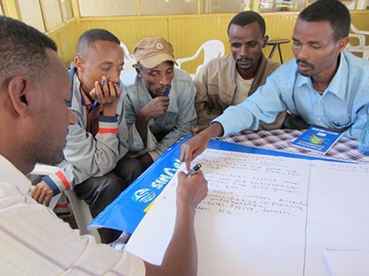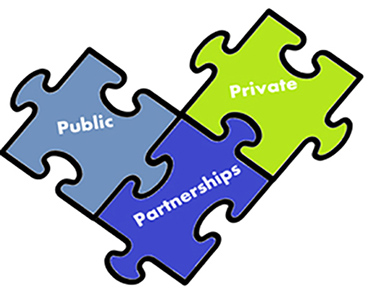4.5 Partnership
Partnership is one of the most important development concepts to have emerged in recent years. The core concept of partnership is sharing tasks and responsibilities in any development sector (Figure 4.3). In other words, partnership is an agreement to carry out a certain task together that will benefit all involved according to their own interests, and bring results that could not be achieved individually. Good partnership reduces duplication of effort. It creates synergy, enhances the efficiency and effectiveness of resources used, promotes innovation and maximises the impact of development programmes.

Governments have been facing the ever-growing demand from their people for basic social services such as education, health, water and sanitation, which they could not address alone. This recognition has led to the inclusion of ‘partnership’ as one of the OWNP’s Guiding Principles. In the POM (POM, 2014), the general framework of partnership across the OWNP is described as:
The OWNP recognizes Civil Society Organizations (CSOs) and the Private Sector as significant partners playing an essential part in attaining OWNP target along with the four sector Ministries and Development Partners.
Let us consider a practical example of partnership in action. If you were a Health Extension Worker with an assignment to promote handwashing practice, it is possible that community members may challenge you. They might say that soap is not available at the local market or they may complain about the price. How would you solve this problem? You may not be able to find a solution to this problem on your own; you may need external support such as a private agent who is able to supply soap to local vendors or open an outlet to sell soap and other goods essential for the community. In other words, you will need a partner.
How should you go about arranging a partnership? We will continue with our example of access to soap as an illustration of the required steps:
Step 1: Preparation
Preparatory work is crucial for developing a steady and effective partnership. You need to carefully examine the condition in which your partnership will be operating. You should assess whether the people are willing and economically able to buy soap or not, and if alternatives are available. Also you need to identify the right partner and list clear roles for them, the community members and yourself.
Step 2: Draw up an agreement/contract
A partnership is often based on a formal commitment signed as a contract or agreement. Bound by the signed contract, you and your partner will share a strategy and implement the work schedule in a coordinated and agreed manner for a specified period. For example, you would make an agreement with your partner that they would supply soap of a specified quality and quantity with an agreed price at a certain outlet accessible to users. Your side of the agreement would be to facilitate marketing by creating demand through hygiene education in the community.
Step 3: Outline the work programme/schedule
The work schedule should indicate the interests and targets of yourself and your partner. It should include activities and measures that will contribute to the successful accomplishment of the activities, according to the roles and responsibilities mentioned in the partnership agreement. Your partnership agreement signed with the soap supplier, for instance, should set out the frequency of soap deliveries and the duration of the scheme.
Step 4: Implementation
In this phase you are required to be in regular contact with your partner to coordinate implementation, to extend and supplement the working programme with new measures, and in some cases to test new approaches if necessary. You work closely with your soap-supplying partner to see whether the joint plan is working properly.
Step 5: Monitoring
To assess the achievements of any partnership and determine possible improvements to be made, a comprehensive monitoring system should be used. A partnership should be evaluated periodically and reports shared. For the soap example, you could assess the achievements of your partnership by evaluating the status of users’ satisfaction in terms of access, price and quality of soap, as well as whether it has encouraged people to use soap routinely, etc. You both would also want to assess the feasibility of the scheme as a business.
Partnerships can be established not only with a private agent but also with any sort of organisation. However, partnerships between governments (public sector) and private parties are very common in development endeavours, including WASH. This type of work collaboration between a public or government office with a private sector operative is known as public–private partnership (PPP) and is depicted in Figure 4.4.

Figure 4.4 depicts public–private partnerships as three interlocking pieces of a jigsaw puzzle. Why is this an appropriate image for PPP?
The jigsaw shows how partnerships can join public and private sectors together to build a bigger ‘picture’. Partnership enables both sectors to fill the gaps they each have. If you remove the partnership ‘piece’ of the jigsaw, both public and private will have unfilled gaps or spaces.
4.4 Harmonisation
